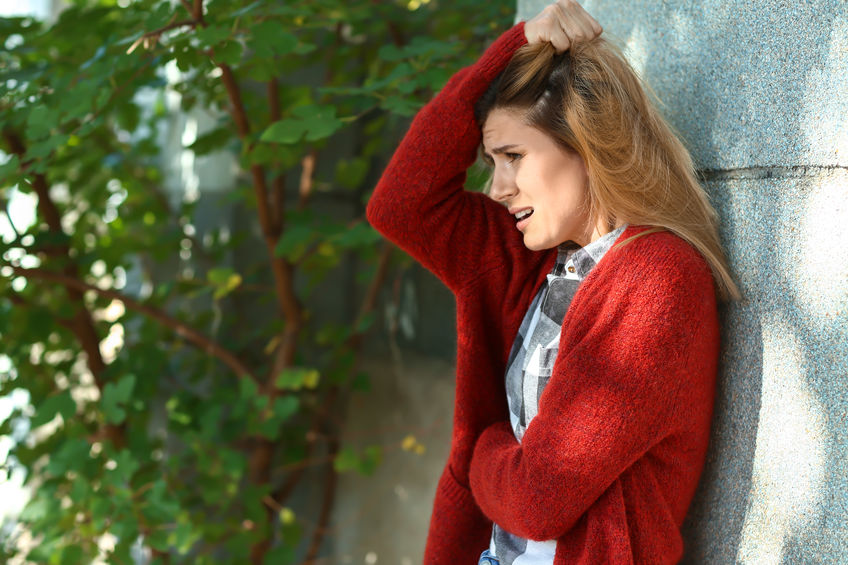Feeling stressed or afraid sometimes is part of our lives. For example, you may have concerns about paying the bills, you may feel ashamed in an embarrassing situation or be nervous about an exam. These thoughts and emotions are real and realistic because there is something at stake. If all goes well, they will make sure you take action, and they are temporary and manageable. But what if you suffer from anxiety and panic often or for a long time?

Getting overloaded
Our autonomic nervous system is able to make the body properly cope with moments of threat and danger. With the mechanism of fight or flight we ‘survive’ the difficult situations. But there are limits to what the body can handle. Constantly being alerted by stressful stimuli, like crowdy environments, continuous deadlines, social media, or having relationship problems, our body remains in survival mode. It can no longer relax, and mentally we feel under pressure. It is not uncommon for us to develop symptoms of anxiety and panic.
Special situations
A panic attack usually peaks within a few minutes and the symptoms can be very frightening. Several things can happen to you: palpitations, accelerated heart rate, shaking, feeling suffocated, sweating, getting out of breath, chest pain, nausea, dizziness, getting hot or cold, fainting, getting out of yourself or being afraid of going crazy or dying.
In panic, we breathe faster, in the upper chest, irregular, loud, through the mouth and with more sighs. We breathe in a much larger volume of air than is necessary and beneficial. An important effect of that heavy breathing or hyperventilating is the loss of carbon dioxide (CO2), a gas that is produced and exhaled by the body. The consequences can be large. If too little carbon dioxide is left in the body, then body cells in the brain will receive too little oxygen (due to the Bohr effect). So thinking clearly and staying calm is much more difficult.
Not everyone is equally vulnerable to stress and anxiety. It is related to personal characteristics and circumstances. A special group are the people who get anxiety complaints more often are those with respiratory diseases. For example, this study (2014) shows that people with sleep apnea are more likely to have an anxiety disorder. This article (2014) describes that 40% of COPD patients suffer from clinical anxiety problems. A 2013 review study describes that COPD patients have more anxiety problems, particularly social and specific phobias, and women are more likely to develop a panic disorder.
Hypersensitivity
With anxiety, people generally breathe faster with a numer of consequences. Anxiety and heavy breathing maintain each other through hypersensitivity to carbon dioxide (CO2). This hypersensitivity makes you more likely to feel of shortness of breath and to breathe faster or heavier as compensation. And this is precisely what exacerbates hyperventilation. The ratio of oxygen to CO2 in the body becomes unbalanced. One of the consequences is that the brain gets less oxygen and you can’t keep thinking as well as you normally do.
When we are anxious or angry, something else changes: the body makes more adrenaline and norepinephrine. These stress hormones increase the sensitivity to CO2 by another 30%, which in turn gives an extra impulse to hyperventilation. Those who are prone to panic attacks will react more strongly to a feeling of shortness of breath, without realizing that this is caused by overbreathing.
Breathing calm, less anxious
So, as we now know, there is a strong interaction between breathing and anxiety. How you breathe also determines whether you react more or less anxiously. If the balance between oxygen and CO2 in the blood is disturbed, you become more sensitive to anxiety and panic. With the proper breathing exercises, you can break this vicious circle and restore the balance so that hyperventilation stops. This is what happens: with exercise in lighter and slower breathing, the production of the stress horizons adrenaline and norepinephrine decreases ⇒ the sensitivity to CO2 decreases ⇒ brain get more oxygen ⇒ you can keep thinking better and calmer ⇒ you stay calmer when ‘in danger’ ⇒ the breathing remains lighter and slower ⇒ and so on.
Daily practicing
With the Buteyko method you train your breathing to a healthy breathing pattern. You start with switching from mouth breathing to nasal breathing. Your breathing gradually becomes slower and lighter, with better use of diaphragm. The breathing in the upper chest will be transformed to breathing low in the abdomen which leads to a better balance of the autonomic nervous system.
With daily exercises in reduced breathing, the ‘Control Pause’ will increase. This is the number of seconds your breath pauses between an exhalation and the first impulse to breathe in again. It is an indicator of how sensitive the body responds to CO2. Gradually, the breathing will slow down and the volume of breath will decrease to what is appropriate given the physical exercise at that time. You get a more balanced breathing rhythm where the exhalation is slower than the inhalation. This will make you less vulnerable for anxiety or panic attacks.
Learning Buteyko
You can learn the Buteyko method in an individual course, with meetings live or online (by video calling), or with a combination of the two. At our office in Hoofddorp, the sessions will take place in compliance with all Corona measures. For children and teenagers up to about 14 years there is a special program.
How is your breathing now?
Buteyko has developed a simple test: measuring the Control Pause. This test is explained here. With children up to 13 to 14 years of age, we use a different measurement method; we count their ‘steps’. Please contact us if you want to try this at home.
Having anxiety or panic attacks?
Please feel free to contact us and request a free consultation. Or read more about out the content of the Buteyko course and how to sign up.
